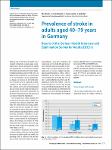Prevalence of stroke in adults aged 40–79 years in Germany
Results of the German Health Interview and Examination Survey for Adults (DEGS1)
Busch, Markus
Schienkiewitz, Anja
Nowossadeck, Enno
Gößwald, Antje
In the German Health Interview and Examination Survey (DEGS1), data on the prevalence of physician-diagnosed stroke were collected from 2008 to 2011 in a representative population-based sample of 5,901 adults aged 40–79 years. The stroke prevalence in DEGS1 was compared with prevalence estimates from the German National Health Interview and Examination Survey 1998 (GNHIES98). The lifetime prevalence of stroke in adults aged 40–79 years is 2.9% (women: 2.5%; men: 3.3%). In both sexes, the prevalence increases continuously with age, up to 6.3% in women and 8.1% in men 70–79 years old. More pronounced in women than in men, the prevalence of stroke decreases with increasing socioeconomic status. Compared to GNHIES98, there is no evidence for a change in stroke prevalence over time. The prevalence of stroke in adults aged 40–79 years in Germany is comparable to prevalence estimates from other national and international studies. Further studies should examine the reasons behind stable prevalence rates, accounting for population ageing and changes in incidence, mortality and case fatality rates.
No license information

